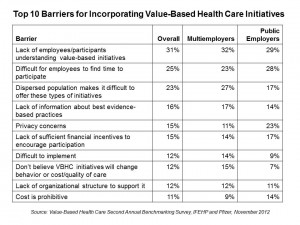 The vast majority of employers who sponsor health benefits look at those benefits as part of a larger organization culture of health. While one-third are adopting value-based health plan strategies — doubling from 16% in 2010 to 37% in 2011 — only 3% of employers are taking an integrated view of value-based benefits and corporate wellness.
The vast majority of employers who sponsor health benefits look at those benefits as part of a larger organization culture of health. While one-third are adopting value-based health plan strategies — doubling from 16% in 2010 to 37% in 2011 — only 3% of employers are taking an integrated view of value-based benefits and corporate wellness.
This is the second year for the International Foundation of Employee Benefit Plans (IFEBP) and Pfizer to examine employers’ approaches to value-based health care (VBHC). As explained by Michael Porter, the guru on health value chains, value in health care focuses on the patient at the center: this is measured, then, in terms of patient outcomes, and not cost-inputs. Thus simply focusing on cost reduction without regard to outcomes achieved, Porter says, is “dangerous and self-defeating, leading to false ‘savings’ and potentially limiting effective care.” Measuring outcomes is based on the actual results of care in terms of patient health: this is multidimensional, considering survival, functional status, sustainability of recovery, and other factors that, together, encompass total patient benefit. Value-based health care pays for quality of care based on pre-agreed measures of quality, incentives, and transparency.
According to the Value-Based Health Care Second Annual Benchmarking Survey, most employers haven’t yet embraced a “culture of health.” While 3 in 5 employers offer wellness programs, these don’t integrate into larger health goals, and therefore don’t generate optimal returns-on-investment. The survey found that most sponsors of wellness programs aren’t actively engaging participants in the design and development of the programs. Furthermore, most employers sponsoring health benefits aren’t monitoring the health risks of enrollees as fully as they ‘should,’ according to their self-assessments.
VBHC encourages individuals to take more responsibility for their own health, but employers admit they largely don’t implement strategies that motivate and engage people to be more collaborative in their health. While developing strategic partnerships with community-based organizations such as pharmacies and other third parties could help extend a culture of health closer to where patients “live, work, play and pray,” most do not engage in such affiliations.
While today’s snapshot into VBHC and cultures of health shows a fairly flat, stagnant picture, IFEHP forecasts that there are “promising signs” that value-based health will grow. Over 50% of employers surveyed say they will likely increase their emphasis on wellness and disease management to 2013, as well as their overall approach to value-based care.
The survey polled 543 U.S.-based managers in employer benefit plans and public employer/governmental plans in September 2011.
Health Populi’s Hot Points: Engaging patients-consumers-caregivers in their and their loved ones’ health care is a key ingredient to bending cost curves for employers, patients (whose out-of-pocket costs continue to increase), and taxpayers. However, the IFEBP/Pfizer survey clearly shows that plan sponsors are engaging with patient engagement.
The dominant form of empowering patients among employers is providing enrollees with price information on prescription drugs. But since prescription drugs comprise just 10% of the total health bill as a line item, this low-hanging fruit won’t do the job of addressing the bulk of cost and quality problems in health care.
Specifically, just 1 in 5 health plans provides information on hospital and physician costs to enrollees — with public employers doing a better job of providing this information to participants than private sector employers. On the upside, the proportion of employers overall who are providing “no” information to participants fell from 42% in 2010 to 34% in 2011, so there is some movement in transparency among employers.
In terms of how employers are communicating this information, the most prevalent channels are printed/mailed letters (54%), newsletters (45%), websites and links to online wellness information (37%), face-to-face meetings (35%), and e-mail messages. As people increasingly live their lives using mobile platforms, social networks online should be used to complement these more traditional channels. Health is a 24×7, micro-decision team sport. Thus, engendering a culture of health in peoples’ daily lives will require co-creating tools with users themselves, along with placing them ‘where’ people want to use them.
The culture of health goes well beyond the workplace, where people live, work, play and pray.




 I'm in amazing company here with other #digitalhealth innovators, thinkers and doers. Thank you to Cristian Cortez Fernandez and Zallud for this recognition; I'm grateful.
I'm in amazing company here with other #digitalhealth innovators, thinkers and doers. Thank you to Cristian Cortez Fernandez and Zallud for this recognition; I'm grateful. Jane was named as a member of the AHIP 2024 Advisory Board, joining some valued colleagues to prepare for the challenges and opportunities facing health plans, systems, and other industry stakeholders.
Jane was named as a member of the AHIP 2024 Advisory Board, joining some valued colleagues to prepare for the challenges and opportunities facing health plans, systems, and other industry stakeholders.  Join Jane at AHIP's annual meeting in Las Vegas: I'll be speaking, moderating a panel, and providing thought leadership on health consumers and bolstering equity, empowerment, and self-care.
Join Jane at AHIP's annual meeting in Las Vegas: I'll be speaking, moderating a panel, and providing thought leadership on health consumers and bolstering equity, empowerment, and self-care.